Rulebook
Objective
In this game, players collaborate to create a Political Arena resilient enough to defend the Commons against encroaching enclosures.
Play conditions
This is a collaborative card game that is played by 2 to 5 players. To play, you need a considerable amount of table space and average games can last from 60 to 90 minutes.
Winning condition
The game is won when no more enclosures are present in the Political Arena (the game table).
Losing condition
The game is lost if more than 5 Enclosures are present on the Political Arena at once (so 6 or more is defeat).
The Cards
Let's start by looking at the back of the cards, you’ll notice two families of cards.
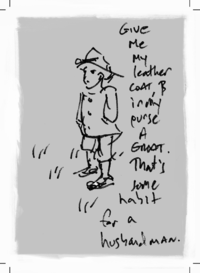
COMMONER CARDS
Cards with white/grey backs are Commoner Cards (player cards).
This deck contains 4 types of cards:
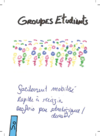
Resources have white frames These cards serve as the players’ “currency” to realize actions and projects (see Basic Mechanics for more information)
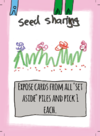
Action cards have pink frames When played, these cards benefit the players with desirable effects.
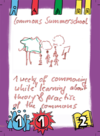
Project cards have purple frames. These cards are the cornerstone of the Political Arena, necessary to campaign against Enclosures and, ultimately, for victory.

Attitude cards have orange frames. These cards apply modifiers to the player's disposition towards collaboration. Note that these are the only cards that must be played as soon as they are picked up. Their effets are applied immediately.
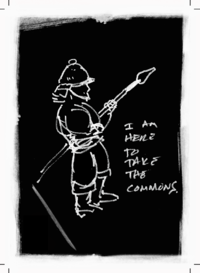
OPPRESSIVE CARDS
Cards with black back are Oppressive Forces (OFs)
This deck contains 2 types of cards.
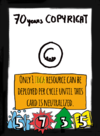
Enclosure cards have a black frame. These compose the main opposition for players. When drawn, these cards apply minor negative effects to the Political Arena (PA) and remain in the PA until they are neutralized.
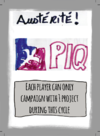
Crisis cards have grey frames. When drawn, these cards have immediate negative effects on players and on the PA. When these card’s effects end, they are discarded.
On OF Phases
On the back of OF cards, one can find numbers which indicate which Oppression Phase each card belongs too. Before play, arrange this deck so that all the cards of the same phase are together (place all the first phase together, the second together and third phase together). (See On Cycles and Oppressive Forces in Playing The Game for further information)
On card effects
Take notice, their are two types of card effects in this game.
- Single Cycle Effects either have an instantaneous effect or last for a single cycle and can be recognized by the grey text box.
- Perpetual Effects have a sustained effect on play and do not get discarded at the end of a cycle. These can be recognized by their orange text boxes.
Basic Mechanics
Placing cards in the Political Arena
When a player takes a card from their hand and places it in PA, we call this a deployment.
Deployed cards are placed in front of the player, in what we call their Network.
All uses and mobilization of cards in a player's network must first be approved by that player.
Deploying Resources
Deploying a Resource has no cost but players are only allowed to deploy one per turn.
Deploying Actions and Projects
Conversly, player can deploy/realize as many Action and Project cards as they can in a single turn if they ca mobilize the appropriate amount of resources required to realize them.
Understanding the cost of deployment
The cost required to deploy a card is displayed at the top of the card, above the title.
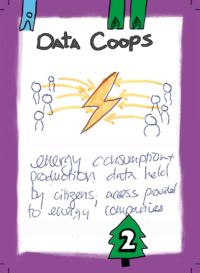
In this example Data Coops "costs" 2 "green" and 1 "blue" to deploy and adds 2 "trees" to the table. Therefore, to deploy Data Coop, players will need to learn about mobilizing resources.
Once deployed, Projects remain in the PA and can campaign repeatedly without requiring the mobilisation of more resources.
How to mobilize resources
To mobilize a resource, players must simply turn a resource currently in the PA 90 degrees (placing it sideways). When mobilized, the resource remains exhausted, unavailable for remobilization until renewed.
Tip: Always ask before using other players resources! They may have other (better?) plans than yours!
On renewing resources
Players can renew resources in their networks at the beginning of their turn.
Towards victory!
As more and more resources are added to the PA, players will soon gain the capacity to deploy Actions and Projects.
To avoid having more than 5 Enclosures in the PA (losing condition), players must campaign to neutralize Enclosures. This is done by sending Projects off to campaign.
Campaigning against Enclosures
To campaign against an enclosure, players assign Projects currently deployed to the enclosure of their choice.
Assigning a Project to an enclosure is a commitment since they will remain assigned to that enclosure until it is neutralized.
On neutralizing Enclosures
On each Enclosure card, there are a set of numbers which refer to this Enclosure's Influence Points (IPs) .
When Projects campaign against an enclosure, the objective is to match or surpasse the Enclosure’s Influence Points by adding up the Influence points of all projects campagning against this enclosure.
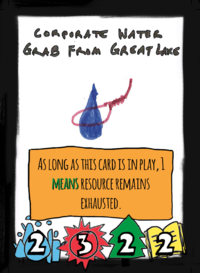
In this example, to neutralize Corporate Water Grabs, players will have to mobilize enough Projects to cummulatively have assigned to it 3 people, 2 methods, 1 means and 3 ideas of IPs.
Tip: when campaigning, place the campaigning projects under the enclosure, IPs showing, so as to track your progress.
When this target is achieved, the Enclosure is discarded and the Project cards return to the PA, in their respective networks.
Conseil : coordonnez vos choix pour faire campagne contre les pires accaparements ! Certains sont faciles à neutraliser, tandis que d'autres appliquent des effets terribles sur le jeu et devraient être défaussés dès que possible! Discutez!
On the color code in this game
This game consistently uses 4 colors to represent the different families of forces/iinfluences acting in the Public Space.

|
Means | Wealth, goods, materials, etc. | 
|
|---|---|---|---|

|
Methods | Social and mobilization technologies | 
|

|
People | Individuals and groups | 
|

|
Ideas | Knowledge, wisdom, memory | 
|
How to play
Setting-up
First, separate the Common deck from the Oppressive Forces deck.
Arrange the OFs by phases and place them so that the 3rd phase is at the very bottom of the deck and 1st phase will be the first to get picked.
Tip: if you want an extra challenge, remove cards from phase 1 & 2! Later cards are MUCH MORE DIFFICULT!!
Place the OFs in the center of the table and distribute 4 cards to each player from the Commons.
Getting started
Before the first player’s turn, draw from the OFs an amount of cards equal to the amount of players, so
- 2 players = 1 OF
- 3 players = 2 OF
- so on.
If no Enclosure is drawn in this first Oppressive Wave, a single OF is added to the until at least 1 Enclosure has been deployed.
Players need to read the card effects currently applied by the OFs since these effects apply initial conditions that players must comply too.
Tip : Remember! Crisis cards are discarded once their effects are completed so they don't count towards the loosing condition!
The player turn
The player wearing the most colors plays first.
This game is played with a closed hand so players cannot show anyone what cards they are holding.
During their turn, players can perform 4 actions :
- Deploy a resource (limit 1 per turn)
- Deploy Project cards
- Place cards from their hand, face down, on top of their “set aside” pile (once per turn)
- Send projects off to campaign against an enclosure.
Furthermore, 2 other player actions can be performed at any time, even outside of their turn.
These are :
- Deploying action cards (by mobilizing the right resources) and
- Using the unique ability of their Attitude card
When players can no longer play, they must declare that their turn is over and finish by drawing the appropriate number of cards to bring their hand back up to 4 cards, either from the common card pile or from the set aside pile.
This declaration will pass the turn to the next player in the cycle.
In the rare event of a player successfully emptying their hand in a single turn without placing cards in their set aside pile, they can redraw 4 cards and continue playing!
Cycles and Oppressive Waves
The first player turn starts a Cycle, where each player will have a turn before the next wave of OFs. Cycles move in a clockwise rotation from player to player.
At the end of the cycle new cards are deployed from the Oppressive Forces. This is called an Oppressive Wave.
On Oppressive Waves
The amount of cards overturned during the Oppressive Wave is relevant to the current Phase. During the 1st phase, 1 OF is added to the PA. During 2nd phase, 2 OFs are added, and so on.
Once the new OFs are deployed, players must take into account their new effects, respond accordingly, and a new cycle begins.
On Phases
Along with affecting how many OFs are drawn, the phase affects how many projects can campaign per player per turn. During the 1st phase, players can send 1 project each to campaign. During the 2nd phase, they can campaign with 2; etc.
Exception! Games with only 2 players can add +1 to the amount of projects that can campaign per player turn.
Phase 3 and the end game
If players reach the 3rd and final phase of OFs and fully empty the pile of OF cards, you're in for quite a challenge!
The player with the most cards in their hand must sacrifice their hand and place each card face down in an unused part of the table.
These cards act as time markers to countdown the amount of cycles left before the game is lost. So 1 card is discarded at the end of each cycle and no new OFs are overturned.
If players succeed at neutralizing the remaining enclosers before the last card is discarded, players win.
On the Set Aside pile
This player option exists to offer a chance to free extra space in your hand in case it is filled with cards that are too advanced for the current state of the PA or if you want to increase your chances of drawing better cards from the Commons deck.
Players can place as many cards as they want from their hand face down in a single pile in their network. When drawing back from this pile, players must start from the first card on top. And no peeking!
Also note that if commoner cards ever run out, shuffle each player's set aside piles together to make a new pile to draw from.
La création d'histoires
Après la neutralisation d'un accaparement ou pendant le déploiement d'Actions et de Projets, vous avez une belle opportunité de raconter une histoire intéressante! Utilisez tout ce que vous voyez, les effets, les ressources liées, les projets en campagne pour trouver une histoire qui rattacherait le tout de façon cohérente ou ludique! De plus, les bonnes histoires seront récompensées!
And good storytelling can also get rewarded!
Each player has the ability to show their gratitude by offering the storyteller the first card on top of their Set Aside pile for free. If accepted, this card adds itself to the storytellers hand. Note that this act can be performed only once per player per game.